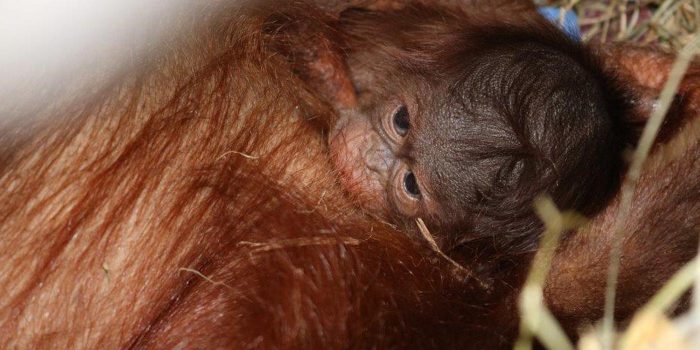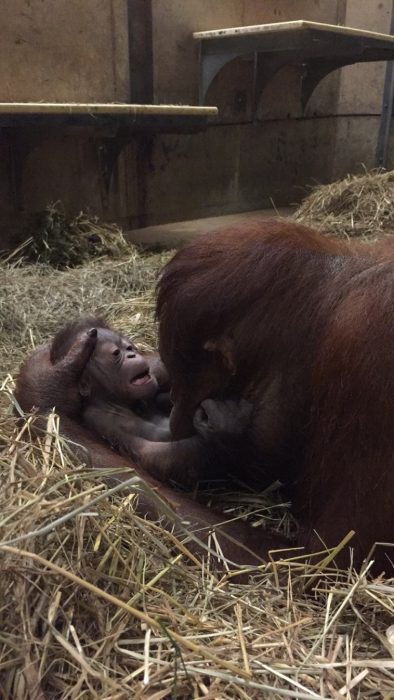It’s a boy!
For the first time in 25 years, a baby orangutan has been born at the National Zoo. The male Bornean orangutan was born at 8:52 p.m. Sept. 12 to 19-year-old mother Batang. The Great Ape House will remain closed indefinitely to provide Batang a quiet space to bond with her infant.

Male Bornean organutan born Sept. 12, 2016 at the Smithsonian’s National Zoo. (Photo by Melba Brown)
Batang and father Kyle, also 19 years old, bred in January following a breeding recommendation from the Association of Zoos and Aquariums’ Species Survival Plan. A human pregnancy test showed that Batang had successfully conceived Feb. 2, and the pregnancy was confirmed with a subsequent ultrasound. The Zoo announced Batang’s pregnancy June 14 through a Facebook Live broadcast of one of her ultrasounds. For the past several weeks, the Zoo has provided weekly updates on Facebook, Twitter and Instagram using the hashtag #OrangutanStory and will continue to share behind-the-scenes photos and videos as news breaks.
“Each and every birth of a critically endangered species is significant, but it is all the more exciting, and this is a historic moment for our Smithsonian’s National Zoo,” said Meredith Bastian, curator of primates and member of the Orangutan SSP Steering Committee. “I am very proud of Batang and my team. Ever since we received the breeding recommendation, they have dedicated themselves to preparing Batang for motherhood. I look forward to watching the infant experience everything for the first time—especially meeting the other orangutans and going outside for the first time with Batang.”

Batang and her infant in the Great Ape House at the Smithsonian’s National Zoo, Sept. 13, 2016. (Photo by Alex Reddy, Smithsonian’s National Zoo)
Animal care staff report that Batang and her infant are doing well. She is very attentive to his needs, holds him gently and consistently nurses him—all encouraging signs. The primate team provided the pair with extra hay and blankets to keep them comfortable. While the other adult orangutans (Kyle, Bonnie, Iris, Kiko and Lucy) have not met the newest addition, Batang—who has always been socially savvy—carried him to the window so Kyle, Bonnie and Lucy could take a peek. Keepers are following Batang’s lead and are looking for behaviors that indicate she’s ready to introduce him to the others.
For the past three years, keepers have been acclimating Batang to the experiences of motherhood and training her to care for an infant. Building upon behaviors Batang has learned through routine training sessions, keepers have trained Batang to hold a baby upright, present it to keepers for bottle feedings and place the baby in a specially designed box when asked. This training enables staff to retrieve the infant if medically necessary and evaluate its health in a way that is safe and not stressful for the animals.
As part of the preparation for all possible scenarios, staff learned how to mix formula and trained females Bonnie and Iris to act as surrogate mothers in the event that Batang was unwilling or unable to care for her infant. The Zoo shared details about Batang’s behavioral changes in her third trimester on social media, including her occasional unwillingness to participate in training sessions and how her tastes in food had become more selective.
Native to Indonesia and Malaysia, orangutans are found only in the rainforests of Borneo and Sumatra. For the past seven decades, humans have cleared land that was originally orangutan territory in order to meet the growing demand for palm oil products, fast-growing pulp wood and food crops, leaving orangutans in competition with one another for space, food and mates. Scientists estimate that in the past 75 years, the number of wild orangutans has decreased by 80 percent. The International Union for Conservation of Nature lists Bornean and Sumatran orangutans as critically endangered.

Batang and her infant in the Great Ape House at the Smithsonian’s National Zoo. (Photo by Amanda Bania)
Orangutans are the most arboreal of the great apes and spend most of their time in trees. Their hair is typically reddish-brown, instead of the brown or black hair typical of chimpanzees and gorillas. Males and females differ in size and appearance. Dominant adult males have distinctive cheek pads and produce long calls that attract females and intimidate rivals. Younger males do not have these characteristics and resemble adult females. Orangutans are the most solitary of the great apes, with social bonds occurring primarily between mothers and their dependent offspring, who stay together for the first two years. Fruit is the most important component of an orangutan’s diet; however, the apes will also eat vegetation, bark, honey, insects and even bird eggs. They can live more than 30 years in both the wild and captivity.
UPDATED SEPT. 26
Zookeepers have chosen the name Redd for the male infant. Orangutans are commonly known as the “red ape” because of their fur color. The Great Ape House at the National Zoo has reopened to the public. Batnag and Redd may not be on view consistently because they also have access to areas not open to public view.
Posted: 16 September 2016




